Events of Sunday 4th May 2014
Introduction
This was my first visit to Rakhine State and I need to do more study to understand its turbulent history better. However, to be going on with, here’s what I gleaned from my Tour Itinerary:-
Mrauk U, once known as Myo Haung, was Rakhine’s capital in the 15th century and was one of the richest cities in Asia and a major trading centre, making it the envy of the Bengalis, the Moguls and the Burmese. During this period, the population of Mrauk U was at least 150,000. The decline was triggered by two major earthquakes in 1761 and 1762 and, by 1784, the famous King Bodawpaya of Burma had annexed Rakhine. Following the first Anglo-Burman war in 1826, the British moved the administrative centre to Sittway and Mrauk U became a backwater, its wealth gone but with a legacy of many monuments and pagodas hinting at its former glories.Although Burmese is the official language, Rakhine is widely spoken. My best attempt at pronouncing Mrauk U is 'em-rah-oo'. The population is now only around 7,000 and there’s significant poverty. There are very few ‘sealed’ roads with tarmac. Most routes are crushed rock and sand, making the small ‘Jeep’ assembled in Myanmar a practical form of motor transport and, of course, there aren’t many of those. For our tours, we had a friendly driver with a second-hand ‘Jeep’ and my guide Mr. Myint Zaw.
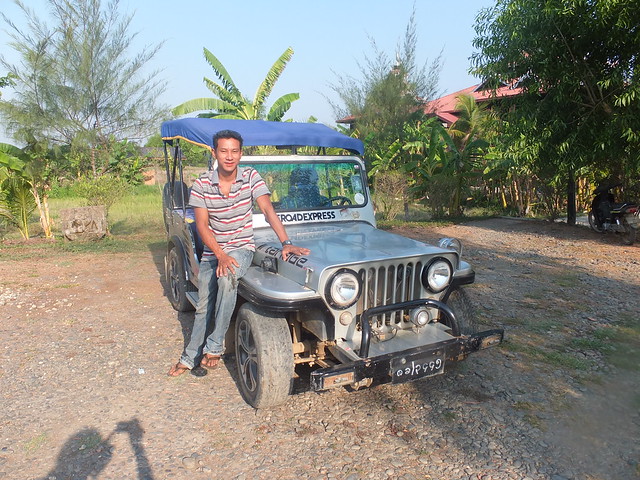 The 'Jeep' and driver which took me and my guide around Mrauk U.
The 'Jeep' and driver which took me and my guide around Mrauk U.
Mrauk U Sunday Market
First, we had a walking tour of the local market. Anywhere in Asia, you can find these vibrant markets with a remarkable range of produce offered under conditions which would send any European Public Health Inspector into apoplexy. Most of the vegetables I couldn’t identify and I needed explanations for some of the other foods. There were live crabs, tree rats, dried fish, cows intestines, various cuts of beef, staples like eggs and lots and lots of curry powder.
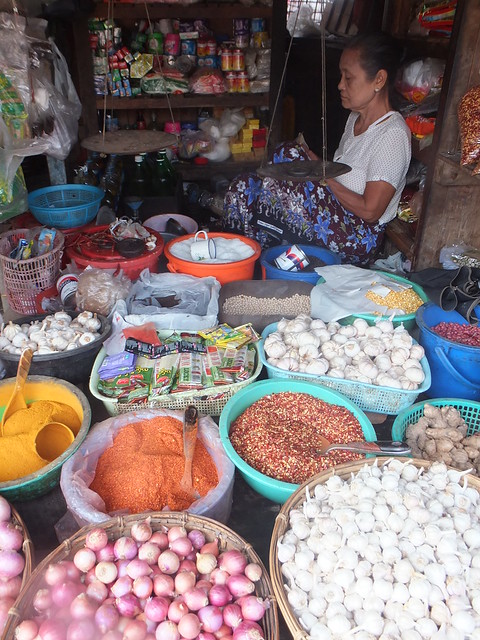
This well set-up stall holder had a conventional, 2-pan balance.
Some of the vendors used the familiar 2-pan balance to weigh the products but most seemed to prefer a more portable version with only a single pan and a balance arm made of wood, looking rather like a small truncheon. I think I’d be a little suspicious of the measurements provided by these single-pan balances.
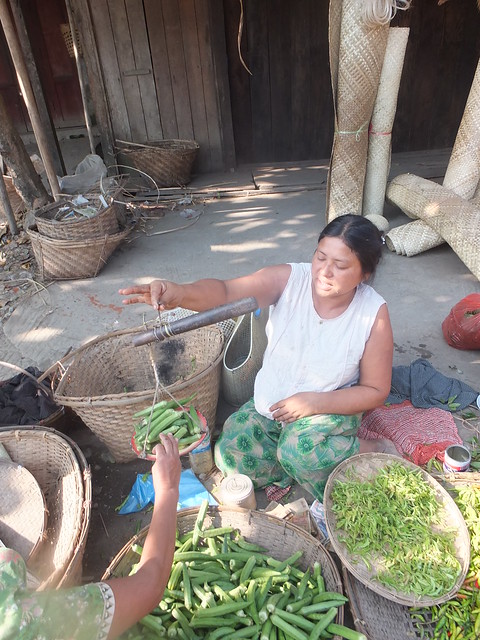
A single-pan balance in use.
New clothing, mainly from China or Thailand was on sale but there was also second-hand clothing which was displayed in heaps on sheets laid on the ground, for prospective customers to rummage through.
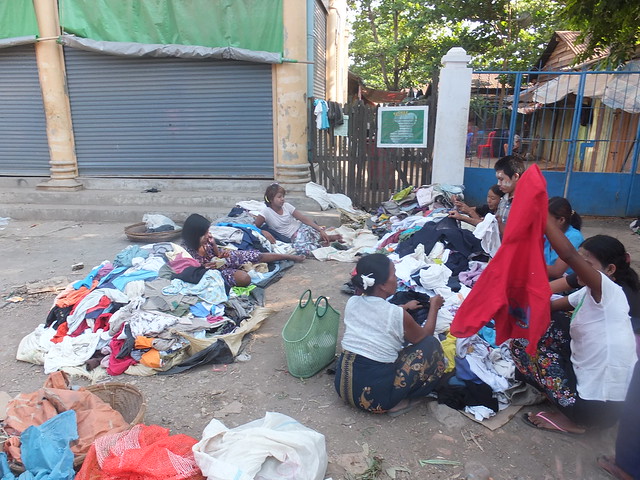 The second-hand clothing stall in Mrauk U market.
The second-hand clothing stall in Mrauk U market.
Football Ground
The Burmese are keen on football, although their enthusiasm sometimes exceeds their playing talent. As we left town, we passed a match in progress at the football ‘stadium’ - a large pitch of beaten earth with goalposts. With a local festival approaching, a series of fixtures had been arranged. A canopy had been provided over the V.I.P. seating area but most of the sizeable crowd were happy to stand along the touch line shouting their encouragement. A café with tables and chairs near one corner of the pitch seemed to be doing a good trade. There were also supporters sitting on top of an ancient wall on the far side of the road. This wall was actually the outer wall of the former Royal Palace.
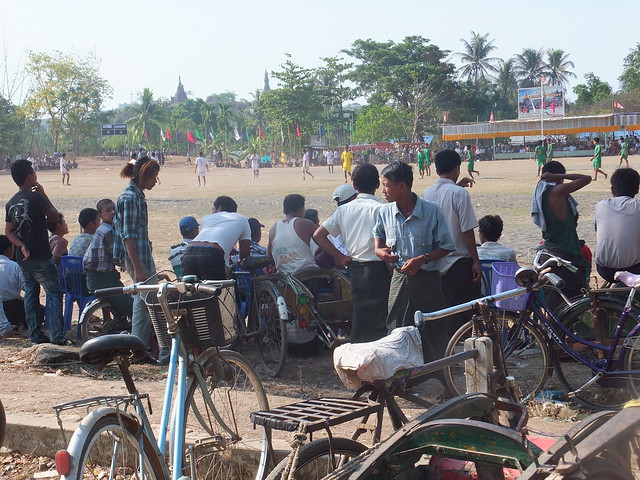 The football match drew a sizeable crowd.
The football match drew a sizeable crowd.
Miphara-gri Cave Temple
The day then took on the familiar format that regular readers may recognise which I call "Jan looked at a load of old temples". We continued on dreadful roads to a hill topped with a ruined cave temple with two stone Buddha images. This was Miphara-gri, the Queen’s Cave Temple donated by Queen Saw Thandar. From the summit, we had splendid views of the Koe-thoung Pagoda a few hundred yards away, which was donated by the Queen's husband, King Tikkha.
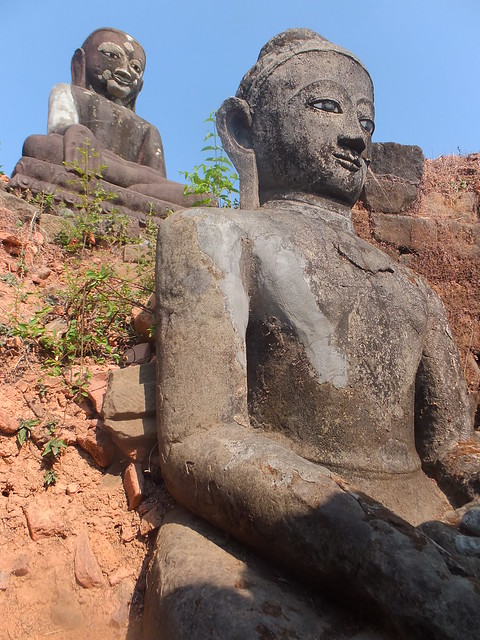 The two Buddha images at Miphara-gri.
The two Buddha images at Miphara-gri.
We could also see the track bed of a new railway under construction, with a part-built station building. The local people are unhappy that this railway has been located so close to these important historic and religious sites.
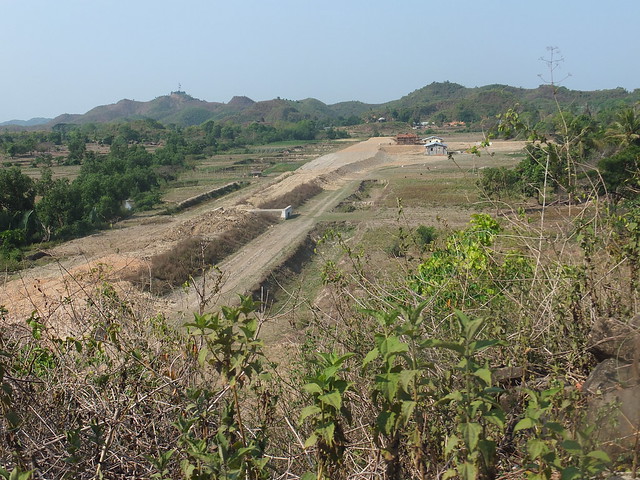 View of the new railway under construction from Miphara-gri.
View of the new railway under construction from Miphara-gri.
Koe-thoung Temple
I was already tired from the heat and the climbing at Miphara-gri as the Jeep took us to nearby Koe-thoung Temple, a very impressive site on which excavation and restoration only started in the last twenty years. It was built by King Tikkha in 1553 and it's the largest temple in Rakhine State - the rectangular base measures 250 feet by 230 feet.
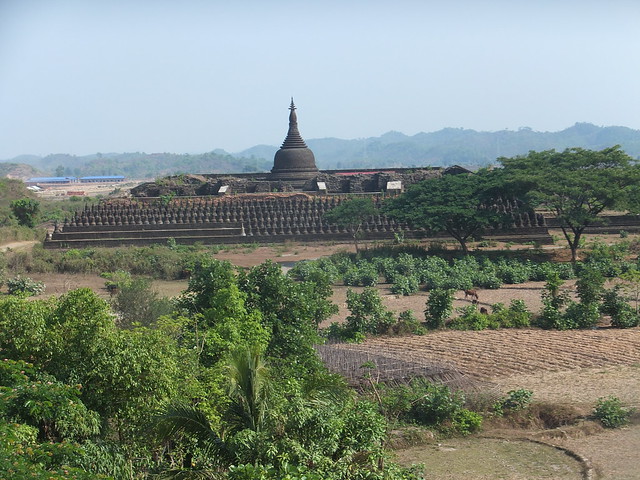 View of the Koe Thaung Pagoda from the Miphara-gri Temple.
View of the Koe Thaung Pagoda from the Miphara-gri Temple.
Koe-Thaung is often referred to as the 'Rakhine Borobudur'. Whilst perhaps not as impressive as Borobudur, I can understand the naming (my own visit to Borobudur in Java is described here with a link to my photographs).
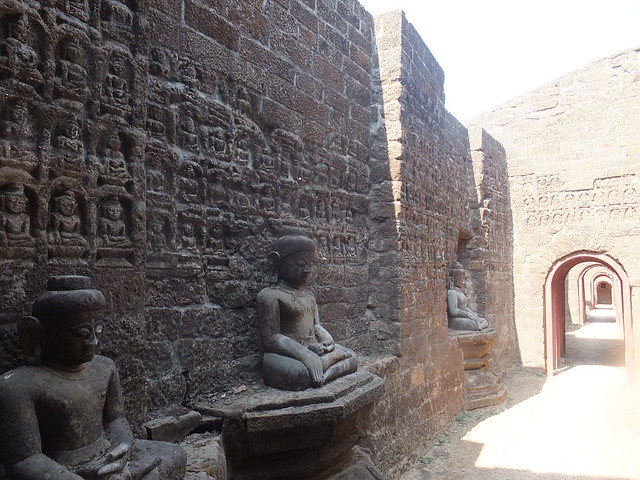 The Lower Vaulted Passage at Koe-thaung, with stone relief Buddha images 9 inches tall covering the walls.
The Lower Vaulted Passage at Koe-thaung, with stone relief Buddha images 9 inches tall covering the walls.
Phra-ouk Pagoda
Returning to Mrauk U, we passed through wooded areas covered with pagodas, somewhat reminiscent of the Bagan pagodas but set in a hilly landscape and incorporating Rakhine architectural features. We paused at Phra-ouk Pagoda, donated by King Phalaung in 1571 (a few more steps for me to climb). The upper part of this pagoda had been destroyed but is now restored. It is notable for the 29 niches facing outwards on the lower terrace, each containing a Buddha image. The main chamber houses a sandstone Buddha image over 12-foot tall which, in recent times, has been painted gold.
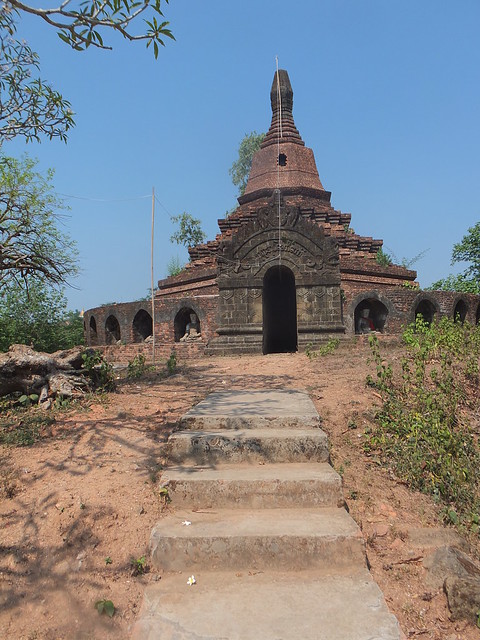
Phra-ouk Pagoda.
The Museum
Some of the more important relics from all the sites around Mrauk-U are now on display in the Museum, which has been built in the grounds of the former Royal Palace. Although the walls of the Royal Palace remain, all the buildings have been lost. After an interesting time in the Museum (alas unrecorded because photography was not allowed) it was agreed that the Guide and Driver would take me back to my Resort so that I could rest before continuing at 4.30 p.m. when the heat of the day was starting to abate.
Shaitthaung Temple
In the late afternoon, the tour continued at the extensive and impressive Shaitthaung Temple, noted for over 80,000 Buddha images, donated in 1535 by King Min Ba Kyi. The stone temple complex was built on a rectangular platform 225 feet by 180 feet by 1,000 workers. We entered via a covered flight of tiled steps leading to a large, fairly modern extension abutted onto the original complex.
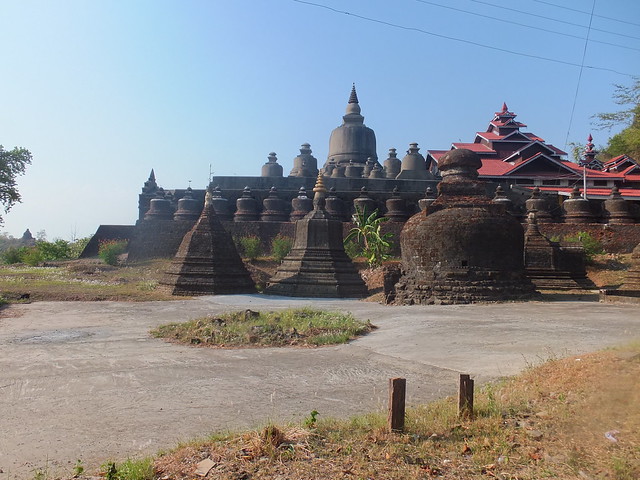 Shaitthaung Temple.
Shaitthaung Temple.
The original complex features a number of internal passages richly decorated with reliefs and carved figures.
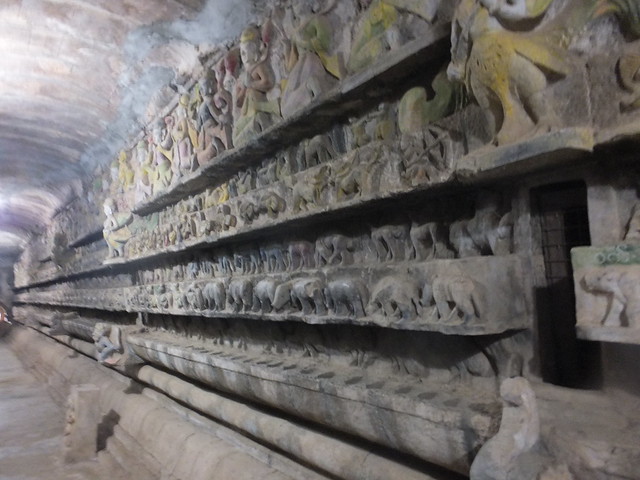 One of the richly-decorated internal passages.
One of the richly-decorated internal passages.
The design and construction of this remarkable complex was supervised by the revered Shun-nge Sara U Mra Wah.
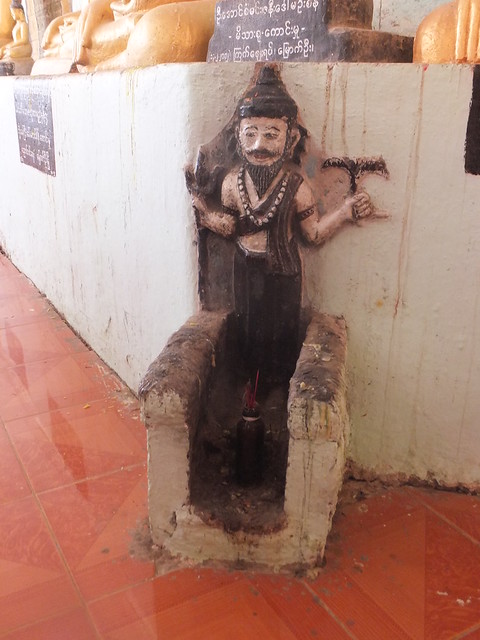 Statue of Shun-nge Sara U Mra Wah.
Statue of Shun-nge Sara U Mra Wah.
The temple contains many treasured relics. As an example, the Ananda Chandra Pillar is a square, stone pillar, over nine feet in height with each face 2 feet 4 inches wide. Three of the four faces are engraved with scripts dating, respectively, from the 6th, 8th and 10th century.
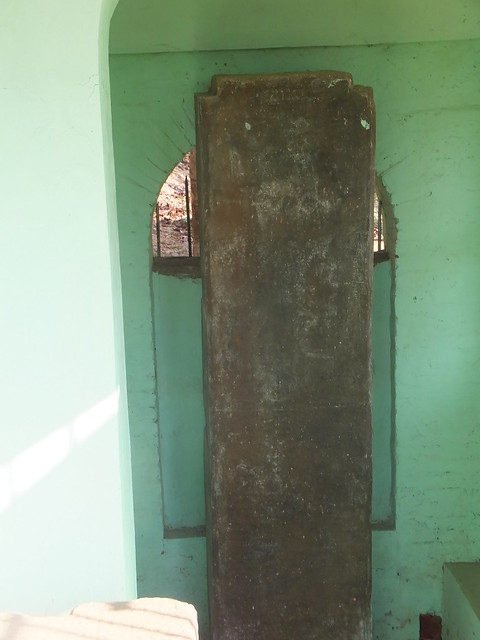
The Ananda Chandra Pillar.
Lay-myut-hna Temple
We then explored the Lay-myut-hna Temple nearby. This was built in 1430 by King Saw Mwan from sandstone blocks and has four entrances. The area was overlooked by the famous Htuk Kant Thein Temple but we agreed to defer our visit here until the following day. I was appalled that three helicopter landing pads had been built here, to allow visiting dignitaries ready access to Mrauk U from Sittwe.
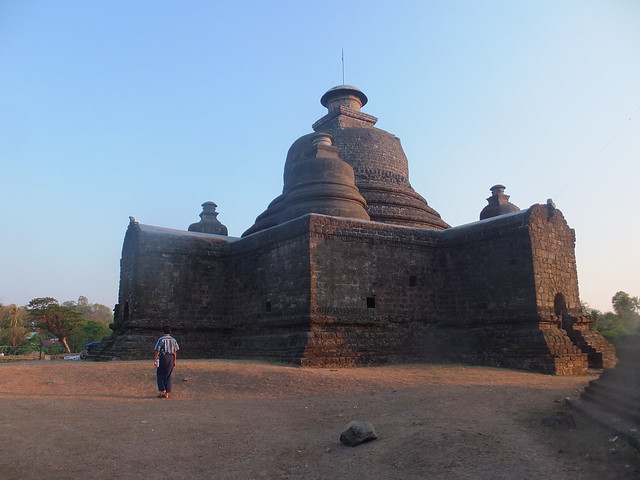 Lay-myut-hna Temple
Lay-myut-hna Temple
There was a pleasant, almost holiday atmosphere – the locals who were able to gathered here to relax and chat towards the end of the day. A group of young men were engaged in a good-natured football match. But, for some people, evening meant going to obtain water for the following day in a daily ritual which becomes more problematic as sources of water, like rainwater ponds, become exhausted until the start of the next rainy season. Young women often carry two of the metal water pots - one on the head, one on the hip. Whilst one young man filled a series of water pots from the pond, the young boy with him enjoyed rides down a slope on the wooden water-cart which they'd shortly load with the water pots before returning home. I’ll return to the topic of ‘Water’ as soon as I can.
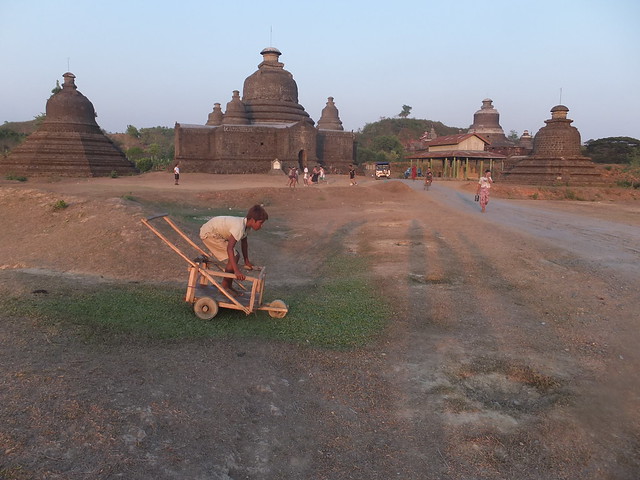 Evening at Lay-myut-hna Temple: A slope allows a young boy to ride in a water-cart whilst young men play football. Shaitthaung Temple is just visible in the background.
Evening at Lay-myut-hna Temple: A slope allows a young boy to ride in a water-cart whilst young men play football. Shaitthaung Temple is just visible in the background.
Tired, I was returned to the comfort of the Mrauk U Princess Resort and its obliging staff.
Books
'Famous Monuments of Mrauk-U' by Myar Aung (ISBN 951536172).
I purchased a copy of this useful and modestly-priced guidebook at one of the temples we visited.'Burma's Lost Kingdoms: Splendours of Arakan' by Zaw Min Yu and Pamela Gutman (ISBN 9748304981).
I've not seen this book myself but second-hand copies are available at a price..
My Pictures
Mrauk U Princess Resort.
Mrauk U and its Market.
Mrauk U: Miphara-gri Temple.
Mrauk U: Koe Thaung Pagoda.
Mrauk U: Phra-ouk Pagoda.
Mrauk U: Shaitthaung Temple.
Mrauk U: Lay-myut-hna Temple
More
Next Post describing this trip.
[Revised 2-Jun-2014, 3-Jun-2014, 4-Jun-2014]
